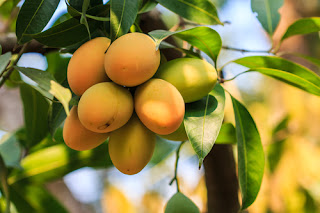MANGO TREE
 |
| MANGO |
Origin
Mango is native to southern Asia, especially Myanmar and eastern India.
Growing
Mangos can be grown in a wide range of soil types, from light sandy loams to red clay. Deep, rich, well-drained soils provide the best production and fruit quality. Some producers plant trees on sloping sites to prevent waterlogging the root system. Mangos grow best in ambient temperatures ranging between 70º to 75ºF. Commercial mangos are propagated vegetatively, meaning the trees are reproduced via asexual reproduction by grafting onto rootstock. There are several main mango cultivars used in commercial production of the fruit. These cultivars are described as either polyembryonic or mono embryonic. Polyembryonic varieties can be grown from seed and produce trees that are true to type. Monoembryonic cultivars contain one embryo that has genes from both parents and produces a hybrid tree (mix of both parents), and therefore, must be reproduced vegetatively by grafting onto a rootstock. Polyembryonic cultivars are often used as the rootstock because they tend to be better adapted to local growing regions and soil conditions, and the grafted mono embryonic cultivars tend to produce fruit with characteristics that are preferred by consumers.
Grafted trees usually begin producing fruit in three to five years, while trees planted from seeds usually take at least five years before bearing fruit. Mango trees can remain in production for 40 years or more. Mango trees require space to grow and are generally planted in rows with 10 to 30 feet between individual trees and 20 to 30 feet between rows. Developing trees are pruned so that there are three to four main branches on the trunk at different heights, and to remove any branches that are less than two feet from the ground. Mature trees are periodically trimmed to allow for better penetration of sunlight, spraying, and ease of picking. Mango trees are annually fertilized with nitrogen, phosphorus, and potassium. Newly planted trees should be watered at planting and every other day for the first week, and then irrigated once or twice a week for the first couple of months. Mature trees do not need frequent watering because of the tropical climate in the regions where mangos are grown. Irrigation may be necessary during occasional dry periods, but the roots can become waterlogged if over-irrigated. Insect and fungal diseases are controlled by pruning diseased branches or spraying with insecticides or fungicides. Fruit flies can be a problem in certain growing regions and may limit distribution of the harvested fruit.
Mango trees begin blooming in the winter months and continue through spring. Most blossoms function as males by providing pollen, but some are bisexual and are self-pollinating. Insects such as flies, wasps, and bees help accomplish pollination. Depending on the variety, the fruit may take from 100 to 150 days to mature, resulting in a late summer and fall harvest. The weight of the mature fruit may vary from the one-quarter pound to two pounds and may be round or oblong depending on the variety.
Weed control
Weeds are usually controlled between rows in an orchard by means of mechanical mowing with a rotary cutter (slasher driven by a tractor). As an alternative chemical mowing, where
herbicides are used, can be applied at low concentrations. The idea is not to kill off all the weeds but to slow down growth. Chemical control is normally followed by mechanical mowing. The advantage of this method is that mechanical mowing is limited, resulting in less traffic in the orchard.
Uses
Having a high stearic acid content, the seed fat is useful for soap-making. The seed residue after fat extraction is used for cattle feed and soil enrichment. Dried mango flowers, containing 15 % tannin, serve as astringents in cases of diarrhoea, chronic dysentery, catarrh, problems of the bladder and chronic urethritis resulting from gonorrhoea. Ripe mangoes may be frozen whole or peeled, sliced and packed in sugar (1 part sugar to 10 parts mango by weight) and quick-frozen in moisture-proof containers.













0 comments:
Post a Comment